
Carphodactylus is a monotypic genus of geckos in the family Carphodactylidae. The genus consists of the sole species Carphodactylus laevis, commonly known as the chameleon gecko. The species is endemic to the rainforests of northeastern Australia. It is rated as Least Concern, as it is common within its range and occurs within protected areas. It currently experiences no major threats, though long-term climate change may alter or reduce its geographic distribution under some scenarios.
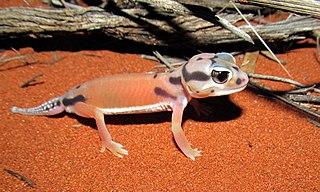
The genus Nephrurus, collectively referred to as the knob-tailed geckos, comprises several species of small, desert-dwelling, drought-tolerant Australian gecko. They are named for their stubby, knob-like tails, and are also easily identified by their rather large eyes. This adaptation of enlarged eyes is indicative of an animal’s lifestyle being predominantly crepuscular or nocturnal.

Phyllurus is a small genus of Australian leaf-tailed geckos, lizards in the family Carphodactylidae. Rarely seen outside their native habitat, they are notable for their highly effective camouflage which is in part aided by the spiny tubercles that cover every body part.

Underwoodisaurus is a small genus of Australian lizards in the family Carphodactylidae. Member species are commonly known as thick-tailed geckos, along with the species Uvidicolus sphyrurus.

The leopard gecko or common leopard gecko is a ground-dwelling lizard native to the rocky dry grassland and desert regions of Afghanistan, Iran, Pakistan, India, and Nepal. The leopard gecko has become a popular pet, and due to extensive captive breeding it is sometimes referred to as the first domesticated species of lizard.
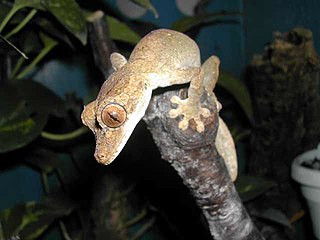
Günther's flat-tail gecko, also known commonly as Güenther's leaf-tail gecko, is a species of nocturnal gecko, a lizard in the family Gekkonidae. The species is endemic to Madagascar.
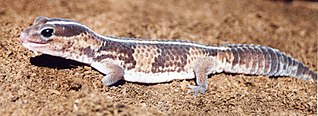
The African fat-tailed gecko or fat-tail gecko is a ground-dwelling species of gecko from West Africa and Cameroon.

Christinus marmoratus, also known as marbled gecko or southern marbled gecko, is a species of Gekkonidae (gecko) native to southern mainland of Australia, from Victoria to Western Australia. The species is well adapted to a variety of habitats, including city dwellings..
Uvidicolus is a monotypic genus of lizard in the family Carphodactylidae. The genus contains the sole species Uvidicolus sphyrurus, also known commonly as the border thick-tailed gecko. The species is endemic to Australia.

Amalosia rhombifer, also known commonly as the zigzag velvet gecko and the zig-zag gecko, is a species of lizard in the family Diplodactylidae. The species is endemic to Australia.

Heteronotia binoei, known commonly as Bynoe's gecko, is a species of lizard in the family Gekkonidae, and is endemic to Australia. One of the continent’s least-habitat-specific geckos, it occurs naturally across much of the country, and has also established in areas where it does not occur normally, such as urban Perth, Western Australia. It is dark brown to reddish-brown, depending on the colour of the ground upon which it lives, as well as irregular light bands with dark edges along its back.

Uroplatus sikorae, commonly referred to as the mossy leaf-tailed gecko or the southern flat-tail gecko, is a species of lizard in the family Gekkonidae. The species is endemic to Madagascar. It is a CITES II protected animal due to habitat loss.
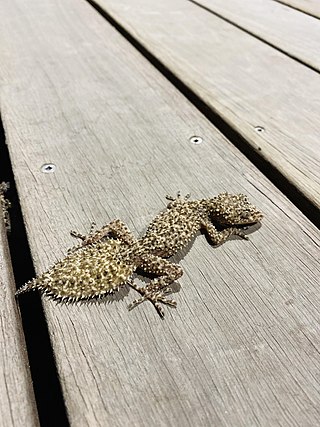
The broad-tailed gecko, southern leaf-tailed gecko, or Sydney leaf-tailed gecko is a common gecko of the family Carphodactylidae found in the Sydney Basin. The species uses its mottled colour to camouflage against bark or rock, and if threatened can drop its large fleshy tail as a decoy. The tail is also useful for fat storage. This species of gecko is available in captivity as a pet, they are a nocturnal ambush hunter, relying on camouflage and patience to catch prey. Primary prey items include large nocturnal invertebrates such as spiders, cockroaches and beetles.

Lucasium steindachneri, commonly called the box-patterned gecko or Steindachner's gecko, is a species of nocturnal, medium-sized lizard in the family Diplodactylidae. The species has a pale strip with three patches of brown along its back. This gecko is terrestrial and only found in arid and semi-arid areas of continental Australia.

The northern spiny-tailed gecko is a species of lizard in the family Diplodactylidae. The species is endemic to Australia.
Lucasium byrnei, also known commonly as the gibber gecko, Byrne's gecko, and the pink-blotched gecko, is a species of small, nocturnal lizard in the family Diplodactylidae. The species is endemic to Australia.

Nephrurus levis, commonly known as the three-lined knob-tailed gecko, smooth knob-tailed gecko, or common knob-tailed gecko, is a native Australian gecko species. The smooth knob-tailed gecko is part of the Carphodactylidae family, a family endemic to Australia. A common, alternative, name for this family is barking geckos due loud barks they make during threat displays, which includes swaying their bodies, winding their tail and attacking with an open mouth. There are multiple sub-species of Nephrurus levis, these include N.l. levis, N.l. occidentalis and N.l. pibarenis. Its aboriginal name is Illchiljera.
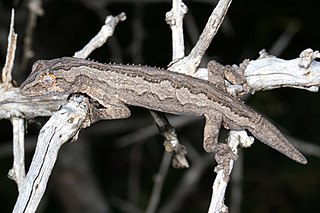
Strophurus intermedius, also known commonly as the eastern spiny-tailed gecko or the southern spiny-tailed gecko, is a species of lizard in the family Diplodactylidae. The species is endemic to semi-arid regions of Australia in New South Wales, Northern Territory, South Australia, Victoria and Western Australia, in mallee shrubland and woodland habitats.

Nephrurus wheeleri, also known commonly as the banded knob-tailed gecko, the southern banded knob-tailed gecko, and Wheeler's knob-tailed gecko, is a species of lizard in the family Carphodactylidae. The species, like all species of Nephrurus, is endemic to Australia.

Strophurus williamsi, also known commonly as the eastern spiny-tailed gecko, the soft-spined gecko, and Williams' spiny-tailed gecko, is a species of lizard in the family Diplodactylidae. The species is endemic to semi-arid regions of eastern Australia including Queensland, New South Wales, Victoria and South Australia. It has become a popular species as a pet for its distinctive tail features. S. williamsi has been grouped within a clade of seven other species that are believed to have diverged from their ancestors around 20 million years ago. S. williamsi can be distinguished from closer relatives by arboreality and diurnal (day-active) activity.



















